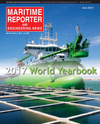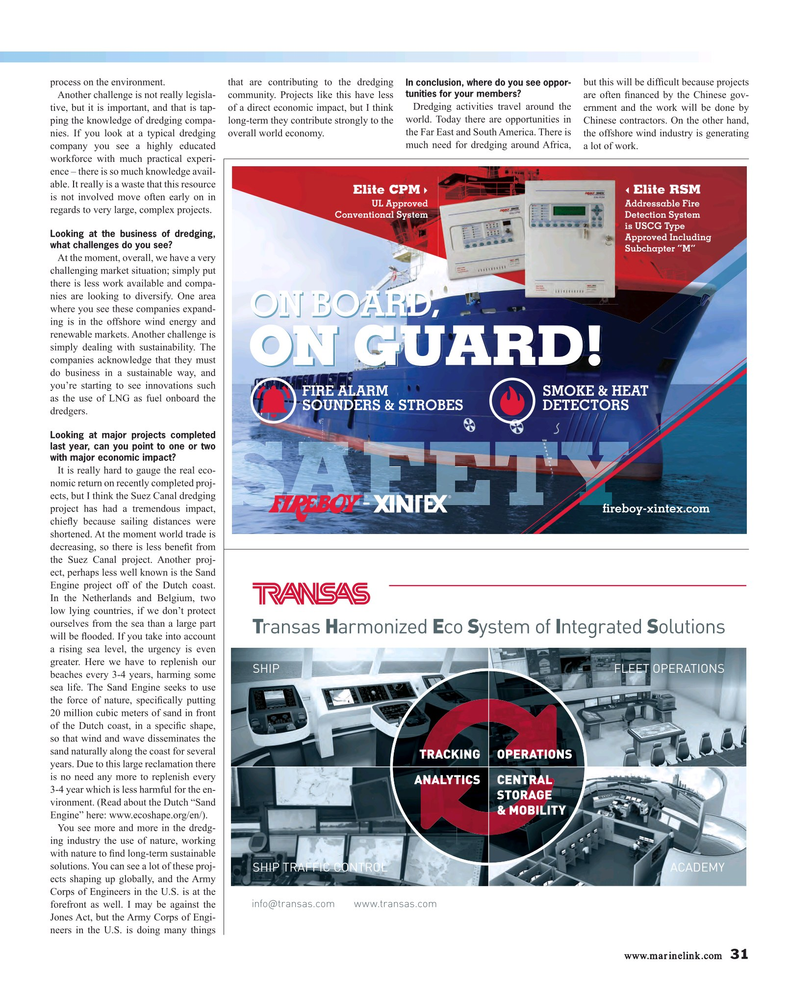
Page 31: of Maritime Reporter Magazine (June 2017)
U.S. Navy Quarterly
Read this page in Pdf, Flash or Html5 edition of June 2017 Maritime Reporter Magazine
process on the environment. that are contributing to the dredging but this will be dif? cult because projects
In conclusion, where do you see oppor- tunities for your members?
Another challenge is not really legisla- community. Projects like this have less are often ? nanced by the Chinese gov- tive, but it is important, and that is tap- of a direct economic impact, but I think Dredging activities travel around the ernment and the work will be done by ping the knowledge of dredging compa- long-term they contribute strongly to the world. Today there are opportunities in Chinese contractors. On the other hand, nies. If you look at a typical dredging overall world economy. the Far East and South America. There is the offshore wind industry is generating company you see a highly educated much need for dredging around Africa, a lot of work.
workforce with much practical experi- ence – there is so much knowledge avail- able. It really is a waste that this resource is not involved move often early on in regards to very large, complex projects.
Looking at the business of dredging, what challenges do you see?
At the moment, overall, we have a very challenging market situation; simply put there is less work available and compa- nies are looking to diversify. One area where you see these companies expand- ing is in the offshore wind energy and renewable markets. Another challenge is simply dealing with sustainability. The companies acknowledge that they must do business in a sustainable way, and you’re starting to see innovations such as the use of LNG as fuel onboard the dredgers.
Looking at major projects completed last year, can you point to one or two with major economic impact?
It is really hard to gauge the real eco- nomic return on recently completed proj- ®® ects, but I think the Suez Canal dredging project has had a tremendous impact, chie? y because sailing distances were shortened. At the moment world trade is decreasing, so there is less bene? t from the Suez Canal project. Another proj- ect, perhaps less well known is the Sand
Engine project off of the Dutch coast.
In the Netherlands and Belgium, two low lying countries, if we don’t protect ourselves from the sea than a large part will be ? ooded. If you take into account a rising sea level, the urgency is even greater. Here we have to replenish our beaches every 3-4 years, harming some sea life. The Sand Engine seeks to use the force of nature, speci? cally putting 20 million cubic meters of sand in front of the Dutch coast, in a speci? c shape, so that wind and wave disseminates the sand naturally along the coast for several years. Due to this large reclamation there is no need any more to replenish every 3-4 year which is less harmful for the en- vironment. (Read about the Dutch “Sand
Engine” here: www.ecoshape.org/en/).
You see more and more in the dredg- ing industry the use of nature, working with nature to ? nd long-term sustainable solutions. You can see a lot of these proj- ects shaping up globally, and the Army
Corps of Engineers in the U.S. is at the forefront as well. I may be against the
Jones Act, but the Army Corps of Engi- neers in the U.S. is doing many things www.marinelink.com 31
MR #6 (26-33).indd 31 MR #6 (26-33).indd 31 6/9/2017 9:17:29 AM6/9/2017 9:17:29 AM

 30
30

 32
32
